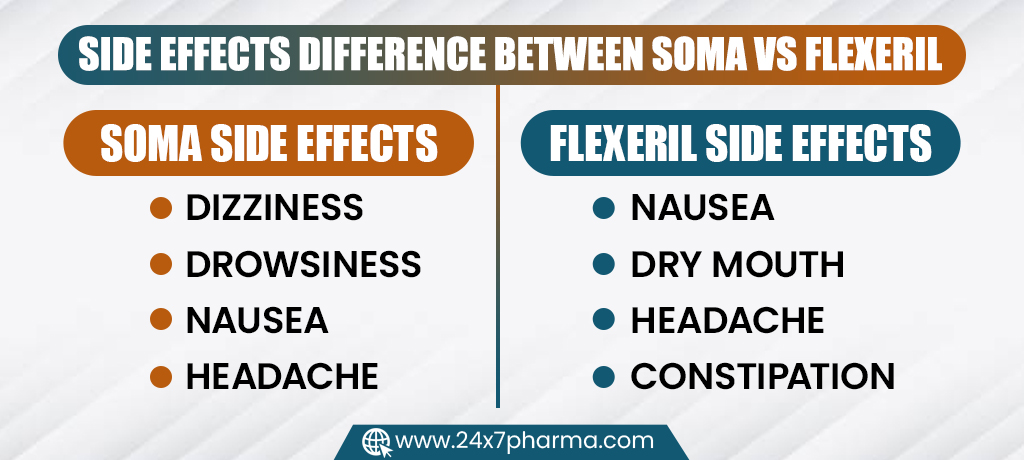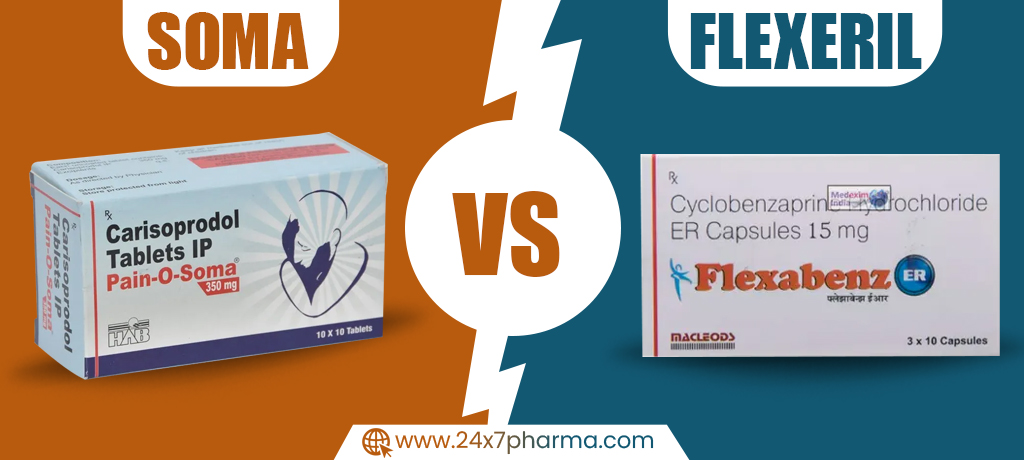Are you struggling with muscle pain and discomfort? You’re not alone. Millions of people in the USA suffer from muscle spasms, tension, and other muscle-related issues and often turn to medications like Soma and Flexeril for relief. But among the two options available, Soma vs Flexeril, it can be tough to decide which is right for you.
Soma (carisoprodol) and Flexeril (cyclobenzaprine) are two commonly prescribed muscle relaxants in the USA and UK that are used to treat muscle spasms, tension, and discomfort. While both medications can effectively relieve muscle pain, they work differently and have potential side effects. Therefore, it is important to understand the differences between Soma and Flexeril before deciding which one to use. The article covers all these specific details about Soma vs Flexeril – Which One to Choose among the two for better clarification conveyed to the patient.
Introduction to Soma vs Flexeril
Soma (Carisoprodol)
Overview:
- Soma, also known as carisoprodol, is a muscle relaxant that works by blocking pain signals from the brain to the muscles. It is commonly used to relieve muscle spasms and discomfort caused by strains, sprains, or other muscle injuries. Soma is typically taken three times a day, with or without food.
Pros of Soma:
- Effective in relieving muscle spasms and discomfort.
- Convenient dosage: Typically taken three times a day.
- Can be taken with or without food.
Cons of Soma:
- Potentially habit-forming if taken for long periods.
- May cause side effects such as dizziness, drowsiness, and nausea.
- Possible drug interactions, especially with sedatives and other muscle relaxants.
Detailed Comparison between Soma vs Flexeril
1. Functioning difference between Soma VS Flexeril
Soma (Carisoprodol):
- Mechanism of Action: Soma is a muscle relaxant that inhibits the transmission of pain signals from the brain to the muscles.
- How It Works: It binds to a protein in the central nervous system, called the GABA-A receptor, which helps regulate muscle tone and movement. By binding to this receptor, Soma helps to reduce muscle spasms and discomfort.
Flexeril (Cyclobenzaprine):
- Mechanism of Action: Flexeril is also a muscle relaxant, but it works in a slightly different manner.
- How It Works: It works by inhibiting the actions of certain nerve impulses in the brain that control muscle movement. Specifically, it inhibits the reuptake of the neurotransmitter norepinephrine in the central nervous system. By inhibiting this reuptake, Flexeril helps to reduce muscle spasms and discomfort.
2.Use Case Difference Between Soma vs. Flexeril
Soma (Carisoprodol):
- Short-Term Relief: Soma is typically used for short-term relief from muscle spasms and discomfort. If you have a minor muscle injury or need relief for just a few days or weeks, Soma can be a suitable option.
- Potential Risks: It is important to note that Soma has a high potential for abuse and can become habit-forming if taken for long periods. Therefore, it may not be appropriate for individuals who require long-term treatment for muscle pain.
Flexeril (Cyclobenzaprine):
- Long-Term Relief: Flexeril is better suited for individuals who need long-term relief from muscle spasms and discomfort. Since it is not known to be habit-forming, it may be a suitable option for those who require ongoing treatment for muscle pain.
- Potential Risks: While Flexeril is not habit-forming, it may still cause side effects like dizziness, drowsiness, and nausea. It can also interact with certain medications, so it is important to discuss potential risks with a healthcare provider.
3.Dosage Difference Between Soma (Carisoprodol) vs Flexeril (Cyclobenzaprine)
Soma (Carisoprodol)
- Recommended Starting Dosage
- Carisoprodol 350 mg or Pain O Soma 350 mg
- Carisoprodol 500 mg or Pain O Soma 500 mg
- Dosage Frequency
- Typically taken three times a day, based on the severity of muscle pain and discomfort.
- Your healthcare provider may adjust the dosage as needed based on your response to the medication.
Flexeril (Cyclobenzaprine)
- Recommended Starting Dosage
- 5-10 mg of Flexeril
- Dosage Frequency
- Typically taken three times a day, with or without food, based on the severity of muscle pain and discomfort.
- Dosage can be adjusted by your healthcare provider based on how you respond to the medication.
4. Side Effects difference between Soma VS Flexeril

Soma Side Effects
- Common:
- Dizziness, drowsiness, nausea, headache, dry mouth, stomach pain, vomiting.
- Severe (Seek medical attention):
- Allergic reaction (rash, difficulty breathing), seizures, chest pain, rapid heartbeat.
- Other Considerations:
- High potential for abuse and habit-forming.
- May interact with sedatives and other muscle relaxants.
Flexeril Side Effects
- Common:
- Dizziness, drowsiness, nausea, dry mouth, headache, constipation.
- Severe (Seek medical attention):
- Allergic reaction (rash, difficulty breathing), chest pain, rapid heartbeat.
- Other Considerations:
- May interact with antidepressants.
5. Precautions: Soma vs Flexeril
Soma (Carisoprodol)
- High Potential for Abuse and Habit-Forming
- Soma has a high potential for abuse and can lead to habit formation if used for long periods.
- Sudden discontinuation may cause withdrawal symptoms.
- Not suitable for individuals with a history of substance abuse or addiction.
- Drowsiness and Impaired Judgment
- May cause drowsiness and impaired judgment, increasing the risk of accidents or injuries.
- Exercise caution when engaging in activities requiring full attention (e.g., driving or operating machinery).
- Interactions with Other Medications
- Soma may interact with sedatives and other muscle relaxants, increasing the risk of side effects.
- Inform your healthcare provider about all current medications to prevent harmful interactions.
Flexeril (Cyclobenzaprine)
- Drowsiness and Impaired Judgment
- Flexeril may also cause drowsiness and impaired judgment, heightening the risk of accidents or injuries.
- Caution is advised when performing tasks requiring alertness.
- Interactions with Other Medications
- Flexeril can interact with antidepressants, increasing the risk of side effects.
- Notify your healthcare provider about all medications you are taking to reduce the risk of adverse effects.
General Recommendations
- Follow your healthcare provider’s instructions carefully.
- Inform your healthcare provider about all medications you are currently using to minimize the risk of side effects and interactions.
Common Precautions for Both Medications
- Follow your healthcare provider’s instructions carefully.
- Always disclose your current medications to minimize potential side effects and interactions.
- Exercise caution in activities requiring full attention while on either medication.
6. Measures that patient can adapt to Soma And Flexeril
- Follow Healthcare Provider’s Instructions
- Adhere to the prescribed dosage and treatment duration.
- Avoid taking more medication than prescribed or extending the duration to minimize the risk of side effects and dependence.
- Use as Directed
- Soma and Flexeril are for short-term relief of muscle spasms and discomfort.
- Do not use them for long-term treatment to avoid dependence and withdrawal symptoms.
- Avoid Activities Requiring Alertness
- Both medications may cause drowsiness and impaired judgment.
- Avoid operating heavy machinery or engaging in activities that demand full attention.
- Maximizing Effectiveness
- These measures help optimize the effectiveness of both Soma and Flexeril while minimizing risks.
7. Factors to consider when deciding between Soma and Flexeril
- Length of Treatment
- Soma: Suitable for short-term relief from muscle spasms and discomfort.
- Flexeril: A better option for long-term treatment due to its non-habit-forming properties.
- Potential Side Effects
- Soma: Can cause side effects like dizziness, drowsiness, and nausea. Habit-forming potential is a concern.
- Flexeril: Also causes similar side effects but is not habit-forming, making it a safer option for those with a history of substance abuse or addiction.
- Other Medications
- Soma: May interact with sedatives and other muscle relaxants, increasing the risk of side effects.
- Flexeril: Can interact with antidepressants. Always inform your healthcare provider about all medications you’re taking.
- Personal Preference
- The decision may come down to personal preference as both medications effectively relieve muscle spasms and discomfort. Consider the dosage schedule, side effects, and habits before making your choice.
- Consult with your healthcare provider to discuss these factors and make an informed decision.


